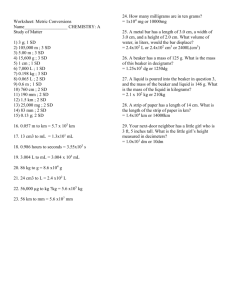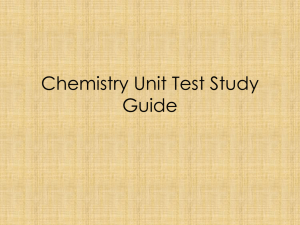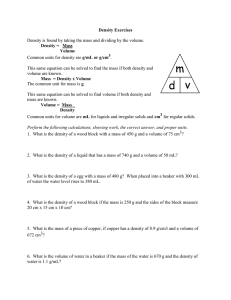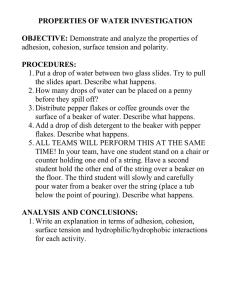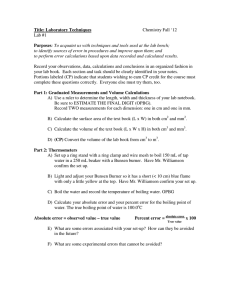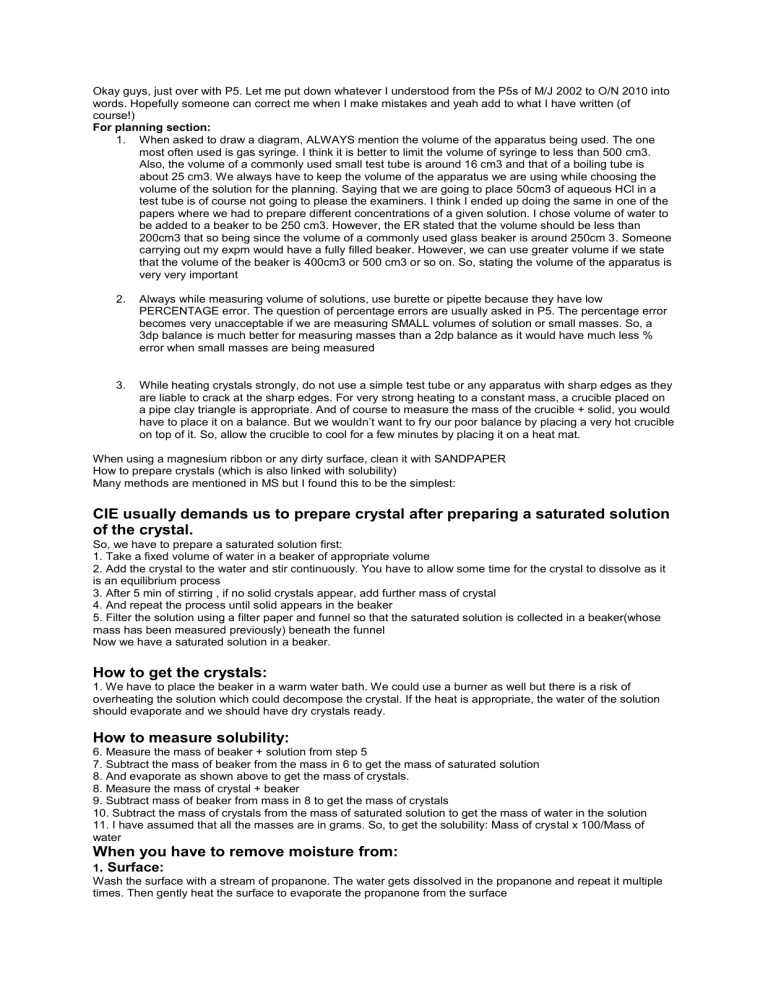
Okay guys, just over with P5. Let me put down whatever I understood from the P5s of M/J 2002 to O/N 2010 into words. Hopefully someone can correct me when I make mistakes and yeah add to what I have written (of course!) For planning section: 1. When asked to draw a diagram, ALWAYS mention the volume of the apparatus being used. The one most often used is gas syringe. I think it is better to limit the volume of syringe to less than 500 cm3. Also, the volume of a commonly used small test tube is around 16 cm3 and that of a boiling tube is about 25 cm3. We always have to keep the volume of the apparatus we are using while choosing the volume of the solution for the planning. Saying that we are going to place 50cm3 of aqueous HCl in a test tube is of course not going to please the examiners. I think I ended up doing the same in one of the papers where we had to prepare different concentrations of a given solution. I chose volume of water to be added to a beaker to be 250 cm3. However, the ER stated that the volume should be less than 200cm3 that so being since the volume of a commonly used glass beaker is around 250cm 3. Someone carrying out my expm would have a fully filled beaker. However, we can use greater volume if we state that the volume of the beaker is 400cm3 or 500 cm3 or so on. So, stating the volume of the apparatus is very very important 2. Always while measuring volume of solutions, use burette or pipette because they have low PERCENTAGE error. The question of percentage errors are usually asked in P5. The percentage error becomes very unacceptable if we are measuring SMALL volumes of solution or small masses. So, a 3dp balance is much better for measuring masses than a 2dp balance as it would have much less % error when small masses are being measured 3. While heating crystals strongly, do not use a simple test tube or any apparatus with sharp edges as they are liable to crack at the sharp edges. For very strong heating to a constant mass, a crucible placed on a pipe clay triangle is appropriate. And of course to measure the mass of the crucible + solid, you would have to place it on a balance. But we wouldn’t want to fry our poor balance by placing a very hot crucible on top of it. So, allow the crucible to cool for a few minutes by placing it on a heat mat. When using a magnesium ribbon or any dirty surface, clean it with SANDPAPER How to prepare crystals (which is also linked with solubility) Many methods are mentioned in MS but I found this to be the simplest: CIE usually demands us to prepare crystal after preparing a saturated solution of the crystal. So, we have to prepare a saturated solution first: 1. Take a fixed volume of water in a beaker of appropriate volume 2. Add the crystal to the water and stir continuously. You have to allow some time for the crystal to dissolve as it is an equilibrium process 3. After 5 min of stirring , if no solid crystals appear, add further mass of crystal 4. And repeat the process until solid appears in the beaker 5. Filter the solution using a filter paper and funnel so that the saturated solution is collected in a beaker(whose mass has been measured previously) beneath the funnel Now we have a saturated solution in a beaker. How to get the crystals: 1. We have to place the beaker in a warm water bath. We could use a burner as well but there is a risk of overheating the solution which could decompose the crystal. If the heat is appropriate, the water of the solution should evaporate and we should have dry crystals ready. How to measure solubility: 6. Measure the mass of beaker + solution from step 5 7. Subtract the mass of beaker from the mass in 6 to get the mass of saturated solution 8. And evaporate as shown above to get the mass of crystals. 8. Measure the mass of crystal + beaker 9. Subtract mass of beaker from mass in 8 to get the mass of crystals 10. Subtract the mass of crystals from the mass of saturated solution to get the mass of water in the solution 11. I have assumed that all the masses are in grams. So, to get the solubility: Mass of crystal x 100/Mass of water When you have to remove moisture from: 1. Surface: Wash the surface with a stream of propanone. The water gets dissolved in the propanone and repeat it multiple times. Then gently heat the surface to evaporate the propanone from the surface 2. Vapour: Use dessicants such as: 1. ANHYDROUS sulphuric acid 2. ANHYDROUS calcium chloride 3. Silica gel You have to pass the vapour from the beaker containing the dessicant Also, a useful property of soda lime is that it absorbs BOTH water vapour and carbon dioxide We are also regularly asked to measure enthalpy changes Most of us already know that we use a plastic cup and thermometer for this purpose However this has many disadvantages (asked regularly) and here are some of them with the required measures: 1. Heat loss to the surroundings from the beaker: To avoid this: a. Cover the plastic cup with a lid b. Place the cup in a beaker. The air in the beaker acts a good insulator. c. Use multiple cups so as to thicken the lateral layer of plastic 2. Instability of the cup a. Place the cup in a glass beaker 3. For exothermic reactions, spray of the solution very likely a. Use a large beaker to carry out the experiment rather than the small plastic cup (which has a small volume) b. Put a lid on the top of the beaker (this only MINIMISES the spray, doesn’t prevent it totally) 4. When we are heating a volume of water in glass beaker, there are two cases of heat loss to consider: a. Heat loss from the beaker of water b. Heat loss from the burner heating the volume of water When preparing a solution of a fixed concentration from a given parent solution of concentration , say, 2.0 mol/dm3 A. We are required to prepare a solution of concentration of 1.0 mol/dm3 with volume 250 cm3 ( the concn cannot be greater than 2 !!!!!!!!!!!!!!) a. Add 100 cm3 of the parent solution to a volumetric flask of marking at 250 cm3 b. Top off with water to the mark of 250 cm3. Use a wash bottle for this purpose to have greater control over the addition process When required to prepare 250 cm3 of 0.5 mol/dm3 solution of a crystal of Mr 50g First realize that we need only 250 cm3, not 1 dm3 Now in 250 cm3 there will be: 50/4 = 12.5 g of the solid So, first add 12.5 g of solid to 50 cm3 of water in a BEAKER (not the volumetric flask yet). Also note that the volume of water is less than 250 cm3. Stir properly and if the solid doesn’t dissolve add more water until it fully dissolves then transfer the solution from the beaker to a volumetric flask. Remember to rinse the beaker with water and transfer the solution to the volumetric flask Stopper the flask and shake properly finally, add the required volume of water to make the solution upto 250 cm3 USE A FUNNEL OR YOU RISK OVERSHOOTING THE MARK Titration is accurate because: 1. Standard solution of acid/base is used 2. We obtain concordant titres 3. % error in pipette and burette is very small 4. The end point of a titration is sharp
